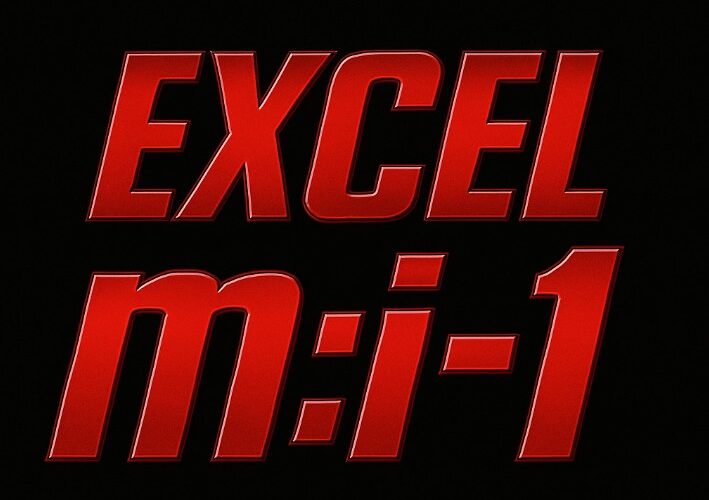Exposing the Gap Between Real-World Business Needs and Social Media Excel Advice
By Hiran de Silva
In today’s business world, critical decisions are made based on the output of business processes—processes that, in turn, rely on data processing. If those data processes are flawed, inefficient, or fragmented, the entire decision-making framework collapses. This chain reaction—from flawed data to flawed insights to flawed business outcomes—poses a serious problem for enterprises. And yet, the way we design these processes is increasingly driven not by business logic, but by social media trends.
Yes, you read that right. Social media—clicks, likes, flashy tutorials, trending terms—has become the invisible hand shaping how many business processes are implemented, particularly when it comes to Excel-based solutions.
The Social Media Trap
Influencers, chasing algorithms rather than accuracy, dominate the narrative about how Excel should be used. Their incentive isn’t to solve your problem; it’s to gain visibility. That means content that is eye-catching, emotionally charged, or overly complex gets rewarded—not content that is genuinely useful or architecturally sound.
The result? Simple business challenges are met with convoluted, bloated solutions that are cryptic, overengineered, and often unsuitable for real-world use. When someone tries to learn from these solutions, they come away either confused or convinced that Excel isn’t the right tool.
This leads to what we call Excel Hell: a world where managers and professionals are asked to use Excel, but only within the narrow confines of what’s popular on social media—not what’s effective in enterprise environments.
The Core Problem: Misalignment of Tools and Tasks
The average LinkedIn or YouTube Excel challenge is often trivial—easily solved with pen and paper—but the solutions are so arcane they appear to require advanced degrees in cryptography. Users are left wondering: If this is what it takes to solve a simple problem, how will I ever solve a real one?
Meanwhile, actual enterprise problems that demand scalable, maintainable solutions are ignored or dismissed as “impossible” to solve with Excel. Influencers say, “Excel doesn’t scale,” or “That’s a job for a proper system,” without realizing that Excel, when used with the right architecture, can absolutely scale and handle enterprise-grade requirements.
Enter the Mission Impossible Series
The Excel Mission Impossible series is designed to turn this broken narrative on its head.
Each episode takes a real-world business challenge—often one that is dismissed as too complex for Excel—and shows how it can not only be solved with Excel, but solved elegantly and simply. The secret lies in thinking differently. Not in learning more features, but in applying architectural thinking, strategic design, and lateral problem-solving.
In short, we show that what looks impossible is often just a case of misunderstanding the problem—or using the wrong approach.
For example:
- A challenge: Assigning seats on multiple charter flights in a way that updates availability in real time.
- The perception: “Impossible in Excel.”
- The solution: A lightweight, user-friendly booking system built entirely in Excel with a centralized database backend. Simple. Scalable. Elegant.
By reframing the problem and applying hub-and-spoke architecture, ADO integration, and sound process thinking, the impossible becomes not only possible—but obvious.
Why This Matters
If we don’t challenge the current narrative, businesses will continue to waste time, money, and human potential on tools and techniques that are either too shallow or too clunky to meet their needs.
We’ll continue to see:
- Projects abandoned because the Excel solution looked too complex.
- Managers discouraged because “Excel doesn’t scale.”
- Whole departments misled into thinking that third-party systems are their only hope—at great cost.
What the Mission Impossible series reveals is this: the real issue isn’t Excel’s limitation. It’s the limited thinking around Excel.
Changing the Culture
The goal of this series is not just to teach Excel. It’s to challenge a culture that confuses popularity with professionalism. That prizes flashy over functional. That pushes features over fundamentals.
By spotlighting real business challenges, scaling them up, and solving them in a clear, understandable, and maintainable way, we hope to:
- Restore confidence in Excel’s true capabilities.
- Inspire architectural thinking over tactical gimmicks.
- Show that the right solution is often the simple one—just hidden in plain sight.
Final Thought
Social media is flooded with Excel content that solves simple problems in overly complicated ways. The Excel Mission Impossible series flips this: we take complex problems and solve them simply.
Not with magic. Not with hype. But with insight, structure, and clarity.






Add comment